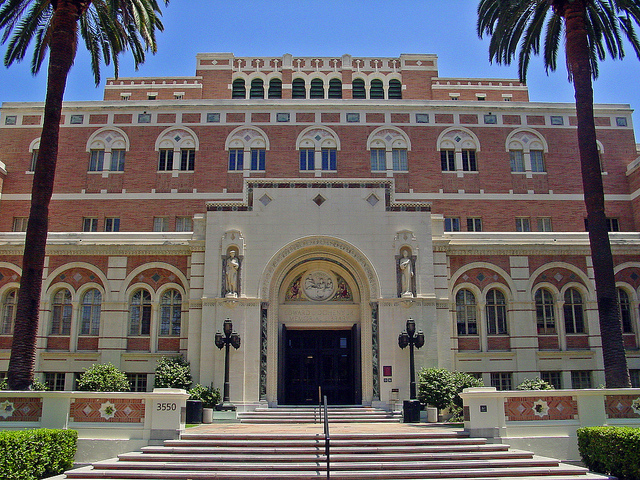Librarianship
Homework Help & Tutoring
We offer an array of different online Librarianship tutors, all of whom are advanced in their fields and highly qualified to instruct you.
Librarianship
All major intstitutions that serve the public, such as schools and hospitals, require an administrative staff to run them, so that they can focus on serving the community. Libraries are no exception, and library administators require highly specialized university training.
.
(Doheny Library at University of Southern California. Photo by Kansas Sebastian via Flickr.com)
Libraries are collections of informational materials in many forms, and are available to the public for borrowing. Early libraries consisted mainly of written archives, but today a library can contain collections of reference materials in printed, digital and recorded form. Managing the collections, acquisitions and staffing, is typically done by a library administrative staff, specially trained for this purpose.
The American Library Association (ALA) is one of the organizations that provides leadership and information to library administrators and students of library administration. According to the ALA website, the main function of the ALA is “to provide leadership for the development, promotion and improvement of library and information services and the profession of librarianship in order to enhance learning and ensure access to information for all.” Outside of the United States, the International Federation of Library Associations and Institutions serves a similar function on a global level.
The study of Library Administraion requires demanding coursework and research. Fortunately, our tutors at 24houranswers.com are prepared to help guide you with any research task or assignment.
A Guide to Library Classification Systems
Library classification systems are used in libraries around the world to classify their books and other materials by subject. They help libraries to place their materials in the proper subject categories by call numbers, call letters, or by identifiers that are a combination of numbers and letters. This enables library users to locate materials more easily, and libraries to keep track of what is in their catalogs.
Many different types of library classification systems are used in libraries throughout the world, but five of them are the most well known. They are:
-
Dewey Decimal Classification (DDC). Known as the Dewey Decimal System to the average person, the Dewey Decimal Classification is the most widely used and most well known library classification system in the world. It categorizes books according to a numerical system that is organized according to groups of tens. For example, 200-299 encompass Religion and Spirituality. Any book covering religion (of any kind) and spirituality is under this category. This type of organization makes it easier for library users to locate books, and to know what subject a book they want falls under. It was created by Melvil Dewey in the 19th century, and is the library classification system most familiar to the general public. In the United States, it is most commonly used in public libraries. The Library of Congress features a Dewey Program that features information on and helps libraries use Dewey at The Dewey Program at the Library of Congress
-
Library of Congress Classification (LCC)−The Library of Congress Classification was created by the Library of Congress. It categorizes books according to subject as does Dewey, but uses letters instead of numbers to designate subjects in its classification scheme. Like Dewey, books are easy to find in LCC, but LCC carries more specialized categories in its scheme, unlike Dewey, whose categories can be more general. LCC's most common use in the United States is in college and university libraries. More information about the LCC is featured at Library of Congress Classification, and an outline of its classification system is featured at Library of Congress Classification Outline.
-
Bliss Bibliographic Classification, version 1 (BC1) and version 2 (BC2)−The Bliss Bibliographic Classification was created by Henry Evelyn Bliss in the early 20th century. It exists in two versions, Bliss Classification (BC1), created by Bliss himself, and Bliss Classification 2 (BC2), created by the Bliss Classification Association starting in the 1960s and 1970s. BC2 is unique in that it incorporates faceted classification, also a characteristic of the Colon Classification created by S.R. Ranganathan. The use of faceted classification enables BC2 to classify materials not just by subject, but by their other characteristics, such as editions, a fact that makes it amenable to today's digital world. Bliss is used at some colleges of Oxford and Cambridge as a classification system for their libraries. To find out more about BC1 and BC2, visit the Bliss Classification Association.
-
Universal Decimal Classification (UDC)−Known and used in many different nations, but rarely used in the United States, the Universal Decimal Classification uses decimal data to create its call numbers. It also bases its structure on Dewey. Visit the UDC Consortium's website to find out more about UDC.
-
Colon Classification−Created by S.R. Ranganathan in India in the 1930s, the Colon Classification uses faceted classification, which means that it classifies materials by facets such as work and manifestation, concepts also used in FRBR and in Bliss Classification 2. This makes it well-suited to classifying digital materials and materials in digital library collections. It has become more well-known in recent decades due to this aspect of its system. The Italian chapter of the International Society for Knowledge Organization features an outline of the Colon Classification.
In spite of their differences, the classification systems listed share at least one characteristic: they classify and organize library materials, thus making it easier for library users to locate materials classified under their systems, and enabling libraries to know what materials they have and do not have, how they are classified, where they can be found in the library, and how to locate and/or replace lost items. Without a classification system, libraries would have a hard time keeping track of their materials, replacing them if they are lost, and knowing what subjects, etc. by which they can be identified. Library users would have a harder time locating and retrieving materials they want. Having a classification system to classify library materials makes easier the lives of librarians and library users, and makes libraries run more smoothly in their day-to-day operations. Finally, it helps catalogers when cataloging new materials introduced into the collection by informing them where to place a book in the library catalog.
Library classification systems aid in maintaining libraries and their collections by organizing their materials in a logical order. This enables libraries to keep house where their materials are concerned, and ensures that library users can use them. Without library classification systems, libraries and the world of information would be much more difficult to use.
Cataloging and Metadata
Cataloging adds records of library materials to the library's catalog, while metadata describes and categorizes information. Both fall under the provenance of Technical Services in a library. The former has been in use for a long time, while the latter is a child of the Information Age. Both cataloging and metadata help libraries to keep track of their collections, aid users in finding items more quickly, and label the subjects that their resources cover.
The process of cataloging varies by the type of item cataloged. If a cataloger is cataloging a book, he or she will record the author, title, publisher, and other information necessary to help users to find it in the catalog. The same principle − making it easier for user to find materials − operates for other formats, ranging from CDs to digital materials. Catalogers follow specific rules when cataloging. The Anglo-American Cataloguing Rules, 2nd Edition (AACR2) is the main rule set catalogers have followed since the 1970s and 1980s. It is being replaced by Resource Description and Access (RDA), which, among its other qualities, makes it easier to catalog digital materials.
Catalogers use subject headings when cataloging materials. The Library of Congress Subject Headings (LCSH) is the most familiar list of subject headings used by catalogers in the United States and, as its name suggests, it was created by the Library of Congress. Other lists of subject headings exist, such as the Sears List of Subject Headings, used by small and medium-sized libraries to assign subject headings to their materials. Subject headings assist catalogers in identifying the subject(s) of a book or other library item they are cataloging, and help them to decide what subject(s) to use when describing what material an item covers.
Cataloging adds new items to a library catalog. Metadata is slightly different, although it also keeps track of materials. It labels and identifies books and other items by subject, author, and other categories used in cataloging. It is, however, more informal and can be created and used by anyone, whether it is to organize an MP3 collection or to denote who authored a book you are reading. The general public's use of metadata is sometimes known as 'creating folksonomies'. When you use metadata, you describe materials using it, and categorize and label them. This is to aid with maintaining library, museum, and archive collections, as cataloging is used to describe physical materials for the same.
Metadata is particularly helpful for describing digital materials, since traditional cataloging seems less able to catalog them as well as it does physical materials. It can be used to describe non-book physical resources also, such as photographs, artworks, and maps. As with digital materials, metadata can describe these items to greater precision than traditional cataloging.
Metadata has digital resources in mind, whereas traditional cataloging was created before the Internet. The categories metadata uses, such as Website, were created to utilize the internet, whereas traditional cataloging has had to develop categories that accommodate it. Traditional cataloging is not always efficient with cataloging digital items. This is where metadata comes in, and makes maintaining digital collections or collections with digital materials easier. It adapts itself readily to digital items.
Some resources that can assist you in learning to catalog include Value of Cataloging Librarians, which is featured by the American Library Association (ALA), and discusses the vital functions catalogers perform. Cataloging Resources, also featured by the ALA, provides a list of resources catalogers can use to assist them when cataloging library materials. Cataloging students will find these resources helpful as they learn to catalog. The Library of Congress features Resources for Cataloging, a list of cataloging resources that both catalogers and cataloging students will find useful.
If you are learning metadata, there are a number of helpful resources available. Many metadata schema exist that help organize metadata, and govern its production by various sets of rules. The most well-known of the schema is Dublin Core, which is a basic schema, and from which many other metadata schema have been made. Other schema include MODS (Metadata Object Description Schema), MADS (Metadata Authority Description Schema), and EAD (Encoded Archival Description).
You may also want to check out the book Introduction to Metadata, edited by Murtha Baca, contributors Anne J. Gilliland, Tony Gill, Mary S. Woodley, and Maureen Whalen, and published by Getty Publications. It is the definitive introductory guide to metadata. Every library school student, librarian, and information professional working with metadata should read this. It is available through the Getty Publications Virtual .
To fulfill our tutoring mission of online education, our college homework help and online tutoring centers are standing by 24/7, ready to assist college students who need homework help with all aspects of librarianship. Our administration tutors can help with all your projects, large or small, and we challenge you to find better librarianship tutoring anywhere.
College Librarianship Homework Help
Since we have tutors in all Librarianship related topics, we can provide a range of different services. Our online Librarianship tutors will:
- Provide specific insight for homework assignments.
- Review broad conceptual ideas and chapters.
- Simplify complex topics into digestible pieces of information.
- Answer any Librarianship related questions.
- Tailor instruction to fit your style of learning.
With these capabilities, our college Librarianship tutors will give you the tools you need to gain a comprehensive knowledge of Librarianship you can use in future courses.
24HourAnswers Online Librarianship Tutors
Our tutors are just as dedicated to your success in class as you are, so they are available around the clock to assist you with questions, homework, exam preparation and any Librarianship related assignments you need extra help completing.
In addition to gaining access to highly qualified tutors, you'll also strengthen your confidence level in the classroom when you work with us. This newfound confidence will allow you to apply your Librarianship knowledge in future courses and keep your education progressing smoothly.
Because our college Librarianship tutors are fully remote, seeking their help is easy. Rather than spend valuable time trying to find a local Librarianship tutor you can trust, just call on our tutors whenever you need them without any conflicting schedules getting in the way.

